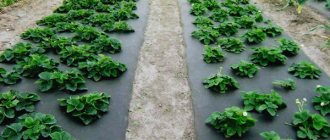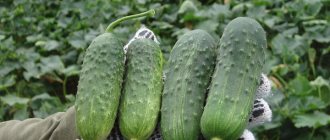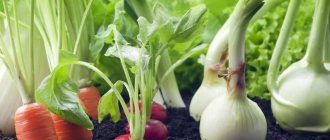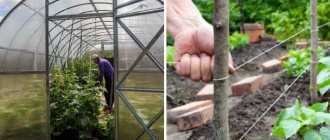Before planting cucumber seedlings in the beds, you should choose the right neighbors for the plants. The health of the cucumbers, the quantity and quality of the harvest will depend on this.
Why do cucumbers grow well and bear fruit next to some crops, while next to others they get sick and fail to produce a harvest? The thing is that plants have an effect on each other, which can be both beneficial and negative. It is especially important to take this into account during compacted plantings, when several crops are grown in one bed to save space.
- Condensed planting in a greenhouse: creating a successful juxtaposition of vegetables
Do you want to get a bumper harvest that will be the envy of your neighbors, but you don’t have much space in the greenhouse? There is a way out - start compacting the plantings.
But no less important is what plants grow on neighboring ridges. Therefore, it is worth carefully selecting “good” neighbors for cucumbers and protecting them from “bad” ones.
Let's look at what questions gardeners most often face when growing cucumbers.
The proximity of plants in a garden bed is one of the most controversial and discussed topics, so you should rely not only on the advice of experienced summer residents, but also on your own observations. It is sometimes not so easy to understand whether some crop really oppresses cucumbers or whether it is a matter of incorrect agricultural practices. We will proceed from the general principles of neighborhood. You can express your opinion on this issue in the comments.
Is it possible to plant tomatoes next to cucumbers?
In general, this is possible. But it’s still better not to grow cucumbers and tomatoes in the same greenhouse or in the same bed in the ground, because these plants need different conditions for growth and fruiting.
| Tomatoes | cucumbers |
|
|
As can be seen from the table, it is quite difficult to create such directly opposite conditions for these crops in one greenhouse; you will have to spend a lot of effort. It is better to plant cucumbers and tomatoes in separate greenhouses or, as a last resort, plant them in a greenhouse as far from each other as possible.
- What can be planted next to tomatoes in a greenhouse and open ground
Tomatoes get everything they need, but refuse to please with a good harvest? Perhaps they just don’t like their garden neighbors.
When practicing mixed plantings, do not forget about annual crop rotation.
What is mixed planting
Mixed plantings involve placing vegetable crops on a small plot of land that have a beneficial effect on each other, taking into account their characteristics
When planting, be sure to follow the rules for arranging plants with each other, taking into account their height, size and ripening period. They should not suppress each other’s growth, but create a certain microclimate or be protected from sunlight or wind
Advantages of mixed vegetable plantings
Growing several types of plants in one place reduces soil fatigue and makes it possible to abandon annual crop rotation. Planting in compliance with all compatibility rules will increase the yield several times by the end of the season.
The main advantages of mixed plantings:
- proper placement of vegetable crops allows harvesting from early spring until the first frost;
- The area of land allocated for a vegetable garden is used more rationally, from 1 sq.m. you can get up to 20 kg of vegetables with the right combination;
- vegetable crops feed on different elements contained in the soil, which helps to avoid unilateral depletion of the soil;
- substances secreted by the roots of one plant influence the taste and size of the neighboring vegetable, stimulating or suppressing;
- the mixture of odors emitted by leaves or fruits of different crops plays the role of chemicals that repel pests or prevent them from finding the desired plant.
Conditions for mixed plantings
Mixed plantings are part of biodynamic farming, which means growing vegetables and berries only using natural forces, without resorting to chemicals and artificial fertilizers. To get as much harvest as possible from each piece of land, follow these tips when planting in a mixed way:
- The width of the future bed should be 1 m. This is the optimal size for further convenient processing and sowing.
- The main, long-ripening crop is planted in the central part of the bed. It could be tomatoes or cabbage. By the end of the season, its growth will increase significantly, and it will occupy the area of the entire bed.
- Something that ripens quickly is planted on the sides of the bed. Such friendly crops can be greens - spinach, radishes, green salad. They are compatible with almost all vegetables and stimulate their growth. While the main crop grows, the side crops will already be collected and space will be freed up.
- Plants for lateral planting are chosen to be small and stunted, with a small root system.
- To protect against pests in an organic way, herbs with a strong aroma are planted in the garden bed - sage, basil, coriander, lemon balm or mint. There should be a lot of them so that the spicy fumes can repel pests and attract beneficial insects.
Undesirable neighborhood for vegetables
When different crops or varieties are grown in one area, an exchange of chemical compounds occurs between them and the plant next door has a direct impact on the quality and quantity of the crop. Before making a plan for planting vegetable and berry crops, figure out what placement should be avoided.
Cucumbers and tomatoes are not planted next to each other. Tomatoes require constant ventilation, and cucumbers require heat and high humidity.
Tomatoes are bad neighbors; they inhibit the growth of vegetables growing nearby. Such proximity does not have a negative effect only on garlic, beans, radishes and greens. Beans and vegetables such as carrots should not be placed next to cabbage; they inhibit the growth of each other. Place celery next to it and get a good harvest of both crops.
Sage and legumes should not be planted near the onion bed; they have an adverse effect on its growth and taste. For potatoes, cucumbers, celery and pumpkin are bad neighbors; close placement of tomatoes is also undesirable. You will not be able to get a good beet harvest if dill or potatoes are planted next to it.
Is it possible to plant peppers next to cucumbers?
Again, not the easiest combination. On the one hand, peppers and cucumbers prefer the same warm climate without drafts, are not related and do not compete for food, but they need different growing conditions. Therefore, it is not always possible to obtain a decent harvest of these vegetables. If you still want to plant peppers and cucumbers in one greenhouse, let there be a maximum distance between them. Otherwise, you will have to constantly monitor whether high humidity harms the pepper or whether the cucumber vines are shading it.
- A good neighborhood: what can be planted next to pepper
Not all vegetables get along well in one garden bed. Today we are choosing neighbors for our beloved bell pepper.
Zoning and partitions
A spacious greenhouse whose dimensions exceed 30 square meters. m, is quite suitable for living together of different cultures. It is desirable that the structure have two doors, one at each end. But you can also use a greenhouse with one door. For comfortable coexistence, it is important to choose the right place for planting.
In the warmest place , near the end window, you can plant cucumbers and place peppers next to them. Eggplants and zucchini can follow. Along the edges of the ridges it is worth planting early white cabbage, leaf and head lettuce, greens or radishes. These crops have a very short growing season; during the summer you can harvest several crops.
In a three-bed greenhouse, you can do things differently. What can you use to plant cucumbers in a greenhouse? Cucumbers are planted in the central bed, , zucchini, eggplants and cabbage are placed on the sides You can sow greens in the spaces between the rows. Those who are going to grow tomatoes in the same greenhouse with cucumbers will have to install lightweight partitions made of plywood, slate or other material.
Mobile film screens stretched over slatted frames are also suitable. Tomatoes are placed in the coolest place , at the exit from the greenhouse. This arrangement will help ventilate the plantings, providing the necessary level of humidity for the tomatoes. Partitions will protect heat-loving cucumbers from the flow of fresh air. You can plant zucchini, cabbage or peppers between cucumbers and tomatoes. It is not recommended to plant eggplants in close proximity to tomatoes; it is better to place them in the cucumber zone .
For successful development and high yields, it is worth equipping the greenhouse with additional windows. They will provide a flow of fresh air to crops that need it. If you plan to frequently ventilate the greenhouse, securely fence off the cucumbers; constant drafts are strictly contraindicated .
The best candidates for neighbors
Cucumbers are grown in a compost or manure bed because they love nitrogen fertilizers. Therefore, all representatives of legumes will be wonderful companions for green crops: peas; lentils; beans; soy; beans.
Leguminous crops have nodules on their roots with specific bacteria that saturate the soil with nitrogen, making it healthier.
The best neighbor for a green vegetable is green beans, which not only actively “share” nitrogen, but also loosens the soil. It is recommended to plant legumes between cucumbers as a seal. This will help to use the area rationally, enrich the soil, and increase the yield of cucumbers due to nitrogenous fertilizing.
Corn has a beneficial effect on the growth and productivity of cucumbers: it creates around itself the microclimate necessary for the normal growth of the vegetable. And if you use tall varieties of grain crops as a compactor, planting them between the beds, then you can wrap cucumber wattles around strong stalks of corn, thereby replacing trellises. It is also good to use sunflower as a similar support for shoots, which will not harm the vegetable in any way.
To increase the yield of the crispy vegetable, you can sow calendula around the beds. The flower will attract pollinating insects with its scent. If dill is planted next to a vegetable crop, then, on the contrary, it will repel pests and parasites with its pungent odor.
Cucumber is well compatible with white cabbage, kohlrabi, Chinese cabbage, onions, lettuce, mustard, and early beets. The following garden plants are neutral to the cucumber neighborhood: strawberries, leeks, carrots, parsnips, celery, garlic, spinach, grapes. Also, cucumber is indifferent to all representatives of cruciferous vegetables (except radishes and radishes).
Is it possible to plant zucchini next to cucumbers?
Cucumbers and zucchini belong to the Cucurbitaceae family and require similar growing conditions, so it is tempting to plant them side by side. According to some summer residents, there will be no harm from such planting, but only on the condition that the zucchini leaves do not darken the cucumber leaves too much, and the plants will have enough fertilizer. It is no longer worth leaving your own seeds from such plants for sowing. But more often, gardeners are faced with the fact that the yield of both crops is not encouraging, and sometimes even completely absent, because the pollination process is disrupted. In addition, related plants are often affected by the same diseases and pests. In this case, powdery mildew often attacks zucchini and cucumbers, quickly spreading throughout the plantings. Therefore, it is still better not to take risks and find different areas for plants.
The powerful root system of zucchini can inhibit the roots of the cucumber, which will interfere with its full development and fruiting.
Review of popular varieties of cucumbers for planting in a greenhouse
All cucumber varieties are divided into two large categories - self-pollinating (parthenocarpic) and insect-pollinated. I recommend planting the latter under the following conditions:
- You have the option of manual, artificial pollination.
- Beehives are installed in the greenhouse.
- You can periodically open and close the greenhouse windows to allow insects access.
I prefer self-pollinating varieties, since it is difficult to attract insects into the greenhouse - you need to plant honey-bearing plants, open the doors and windows wide. Parthenocarpics, which produce predominantly female flowers, require much less time. Their significant advantages:
- Resistant to stressful conditions.
- They grow and develop together.
- Suitable for salting and marinating.
- No bitterness from the fruit.
- Suitable for long-term storage.
- They tolerate storage and transportation well.
- They form seedless fruits. This means that the greens will not turn yellow over time and will retain their freshness, juiciness, and taste even if stored for a long time.
If you choose varietal (insect-pollinated) cucumbers, be prepared to form a bush in a timely manner. Otherwise, the plant will go into the tops to the detriment of the formation of greens. I will list the varieties common among gardeners:
- Home;
- Relay race;
- Marfinsky;
- Zozulya
- Moscow greenhouse;
- Regatta;
- Dawn.
Self-pollinating hybrids are also popular - the plants are suitable for open, protected planting, resistant to fungal diseases, pests, and stressful weather conditions. They are distinguished by high productivity and excellent taste. Hybrids are mainly ultra-early, early ripening, early varieties. Varieties are divided into two groups:
- Dutch selection (F1): Marcella, Masha, Christina, Pasamonte.
- Russian selection (F1): Anyuta, Advance, Angel, Burevestnik, Parquet, Blanca, Gosha, Mila, Real owner, Karina.
If you don’t have time to develop a cucumber bush, I recommend the following hybrids (F1):
- Valdai;
- Izhorets;
- Northerner;
- Sarovsky.
These are short-climbing or single-stemmed self-pollinating plantings that require minimal care.
Deadlines
The seedlings are ready for planting in the greenhouse at the age of 25-30 days. Knowing this, you can count 30 days of growth and 5 days for stable seedlings from the expected planting date; the resulting date will become optimal for sowing seed material for seedlings.
This formula is universal for regions with any weather conditions. It is worth choosing a suitable date for planting seeds, taking into account the equipment of the greenhouse with heating and an additional light source.
How to prepare the soil before planting cucumbers
Pumpkin plants love neutral soil (pH no higher than 6.5). In acidic soil, cucumbers develop reluctantly and take root slowly. Such a substrate is also an ideal environment for the development and activity of pathogenic microorganisms. Therefore, in the fall I recommend liming the greenhouse soil.
checking the soil with a pH meter
Cucumbers prefer loose, “airy”, fertile soils, richly flavored with organic fertilizers. During autumn and spring preparation, I add rotted mullein and compost up to 10-15 kg per 1 m2 for digging a closed ridge.
The following feedings (per 1 m2) are also favorable for cucumbers:
- Superphosphate: 2 teaspoons.
- Stove ash: 2 tbsp. spoons.
- Ready-made nutrient mixture for pumpkin: 2 kg (for example, “Exo”).
Spread the fertilizers evenly over the bed, using a rake to plant them to a depth of 10-12 cm. Additionally, I advise you to use the growth stimulator “Energen”: I dilute one capsule of the drug in 10 liters of water heated to 50 C, stir thoroughly. I distribute the composition over the surface: 2-3 liters of solution per 1 m2 of land. The growth stimulator builds up the humus layer, increasing the fertility of the substrate.
Preparing beds for planting cucumber seedlings
Immediately before planting, water the bed and dig holes. The optimal distance between them is 50-60 cm, the arrangement is staggered. With this planning, each plant will receive a sufficient amount of sunlight.
Water the holes with liquid organic fertilizer. I use Effecton-O: 3 tbsp. spoons per 10 liters of water heated to 300 C. For each well - 1 liter of the resulting composition.
Let me introduce another way to prepare:
- In the fall, prepare the greenhouse soil: mix black soil with humus and ash.
- In spring, disinfect the substrate with a slightly pink manganese solution.
- Cover the beds with agrofibre or film so that it warms up faster.
- After 3 days, remove the material and make holes the size of a glass of seedlings. Arrange them in a checkerboard pattern.
- Fertilize the bottom of the hole with a pinch of Kemira.
The second method is to prepare warm beds in an unheated greenhouse:
- 2 weeks before planting cucumber seedlings, make trenches 20 cm deep.
- Place rotted manure on the bottom, cover it with a thin layer of hay, and cover it with a layer of fertile substrate. You can use the following composition: a bucket of horse manure, 1 teaspoon of superphosphate, 1 glass of ash, 1 teaspoon of urea.
- Fill the trenches with water. You can treat them with a liquid EM product that stimulates the rapid decomposition of organic matter.
By the time the seedlings are planted, the high ridge will sag somewhat due to the processing of organic compounds by soil bacteria. The heat generated during these processes will warm the seedlings.
Growing seedlings
After selecting the container, preparing the soil and seeds, you can begin directly planting the seed material for seedlings. To do this, follow the work algorithm:
- Place a drainage layer on the bottom of the peat pots and fill 3/4 of the pot with prepared soil on top. Place the container in the tray and moisten.
- Make a hole in the middle of the pot, about 1cm deep, and place a couple of seeds in it. Cover them with soil, slightly compacting it.
- Using a sprayer, moisten the soil surface with water and cover with glass or plastic film.
- Transfer the pots to a sunny windowsill or other place with a temperature range of 25-28 degrees.
Remove glass or film daily, moistening and ventilating the crops. This will prevent mold from appearing on the surface of the soil.
Moisten the soil not by watering, but by spraying water using a spray bottle.
Correct temperature conditions are important for seed germination. Shoots appear after 5-6 days at a temperature of 27-28 degrees. When leaves appear, you should adhere to a daytime temperature of 19-22 °C, and at night - 15-17 °C.
When the first leaf forms on the seedlings, fertilize with a solution of complex fertilizer.
Make sure that the plants do not stretch towards the light source. To do this, rotate the containers periodically. As the plants grow, move them away from each other so that the shadow created does not interfere with their quality development.
Is it possible to plant cucumbers next to corn?
fermilon.ru
This planting is quite successful and can significantly increase the yield of cucumbers. In this case, the corn will become a real support for the cucumber vines, which can be tied to the stems. In addition, it will protect the plantings from the wind and scorching sun. The root systems of these crops do not compete for nutrition, but sometimes the cucumber may lack nitrogen. Therefore, carefully monitor the condition of the plants and fertilize regularly.
- How to feed cucumbers during flowering and fruiting to increase yield
Simple and effective recipes for your garden based on yeast, iodine, boric acid, ash and other available ingredients!
Is it possible to plant cucumbers next to garlic?
Gardeners have different opinions about such planting. Some believe that there will be practically no benefit, and the cucumbers themselves can slow down their growth. Others, on the contrary, claim that garlic relieves lashes from angular leaf spot (bacteriosis), aphids, mole crickets, etc. In general, both sides are right. Just to achieve a positive effect, you don’t need to plant garlic too close to cucumbers, keep a distance of at least half a meter.
- What can be planted next to garlic - choosing the right neighbors in the garden
We tell you what to plant next to garlic to get excellent harvests.











